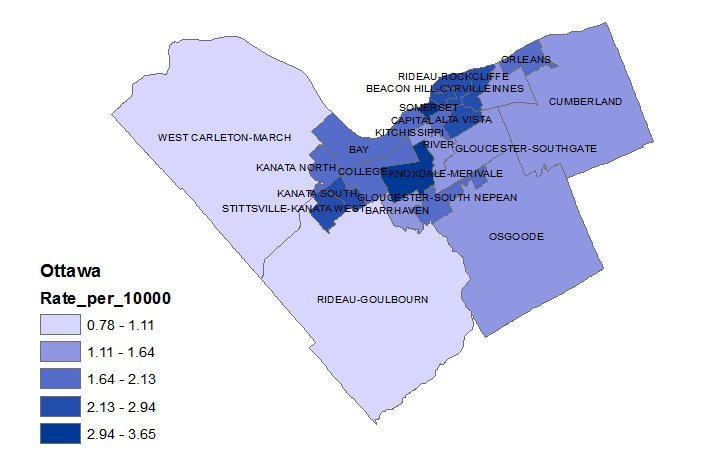Influenza vaccination has not increased in Ontario since the province started allowing pharmacies to give the flu shot three years ago, according an analysis of Statistics Canada data.
Thirty-one per cent of Ontarians aged 12 and older reported getting the influenza vaccine in 2013 compared to 32.9 per cent in 2011, the year before the program expanded to pharmacies, according to data collected through the Canadian Community Health Survey.
David Jensen, spokesperson for the Ontario Ministry of Health and Long-Term Care, said in an email that demand for the flu vaccine has “remained fairly steady” at around 30 per cent of the population for the past five years.
The Ontario government began paying participating pharmacies $7.50 per shot administered in fall 2012. The goal of the program is to increase flu shot accessibility and relieve the burden on public health clinics, which can be “a bit of a zoo,” according to Dr. Jeff Kwong, a medical doctor and public health researcher at the University of Toronto.
Kwong said many people don’t bother getting the flu shot because of three main myths: influenza infection “isn’t a big deal,” the shot doesn’t work and it’s not safe.
“There’s tons of information out there but there’s tons of misinformation out there,” he said.
Kwong acknowledged that influenza isn’t a big concern for healthy people but said opting not to get the shot because it doesn’t work or isn’t safe is just wrong.
The flu shot protects people from the influenza virus but it doesn’t protect against other similar viruses that people often mistake for the flu, leading them to falsely believe the vaccine doesn’t work, he said.
“There are lots of other viruses that are circulating and people say ‘I still got sick,’” he said.
Kwong also dismissed concerns about Guillain-Barré Syndrome, a type of paralysis that patients have a one in a million chance of contracting from the flu shot.
“You’re probably more likely to Guillain-Barré from influenza infection than vaccination,” he said.
Ryan White, a pharmacist at West Carleton Drug Mart in Ottawa, said he occasionally gets clients who are skeptical or nervous about side effects from the flu shot, but the vast majority of people who come in are “highly motivated” to receive the vaccine.
Kwong also said the H1N1 flu pandemic that swept the world in 2009 could have affected influenza immunization rates, particularly in the following year.
“A lot of people were just tired. There was so much hype around the pandemic and the next year it felt like it wasn’t such a big deal,” he said. “They weren’t as scared of it.”
For the 2014-2015 flu season, which runs October to March, there are 195 community clinics, hospitals and pharmacies approved by Ottawa Public Health to give the flu shot for free, and that doesn’t include the private clinics set up by employers.
2014-2015 Ottawa flu season clinics
The Ontario government purchases 4.6 million doses of the influenza vaccine each year, according to Jensen.
“This is usually quite sufficient to meet the demands from all across the province,” he said in an email.
Ottawa pharmacists said demand for the flu shot is consistent so far this season with previous years and while it’s been busy, it’s manageable.
“People are really good about coming back at a later time when it’s really busy,” said White, noting that there have only been a few instances this year when clients at his rural pharmacy have had to wait to get the shot.
“So far we haven’t had to turn anyone away,” he said.
White said he administered about 170 flu shots at his pharmacy last season, their first year participating in the vaccination program, and they’re on-track to give the same number of immunizations this year.
The busiest time for flu shots is right when the vaccine becomes available at the end of October and beginning of November. White said he was giving about 10 to 15 shots per day during that period but now it’s down to as a few as two on some days.
Clinic rate per 10,000 residents by ward
 Ontario public health officials are most concerned about the young and the old receiving the influenza vaccine because they are the most likely to get seriously ill or die from the flu. Up to 1,600 people die in Ontario each year from the flu, according to a 2012 Ministry of Health report.
Ontario public health officials are most concerned about the young and the old receiving the influenza vaccine because they are the most likely to get seriously ill or die from the flu. Up to 1,600 people die in Ontario each year from the flu, according to a 2012 Ministry of Health report.
White said his pharmacy primarily sees people 55 to 75 years old and a smaller number of children five to 12 years old. Children must be older than six months to get the flu shot and older than five years to get it in a pharmacy.
“The vast majority of clients coming in have had flu shots in the past,” White said. “One today noted that he started again because it’s a lot more convenient to come to the pharmacy.”
Donald Sin, a pharmacist at the Glebe Shopper’s Drug Mart, also said demand for the flu shot is consistent with previous years.
“We’ve always done a lot. We’ve always been a very busy store for some reason,” he said.
Sin said staff at the Glebe Shopper’s probably administered 1,000 flu shots last year and was doing as many as 60 per day during the busy period. Currently he is averaging about 10 shots per day.
Unlike White’s elderly client base in West Carleton-March, Sin said his central Ottawa pharmacy sees people of all ages.
The Ontario government runs annual public health campaigns encouraging all people living and working in the province to get the influenza vaccine. A flu information website maps clinics across the province and offers information on vaccine safety in an effort to combat some of the myths outlined by Kwong. It also offers information on how companies can set up a flu clinic in their office.
But ignorant attitudes can be hard to break among a healthy population that just doesn’t see the need for the needle.
“I don’t think we should force people to get the flu shot,” Kwong said. “But it’s hard to change people’s beliefs sometimes.”


